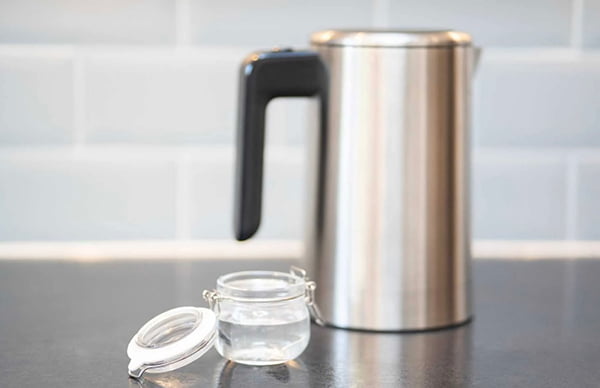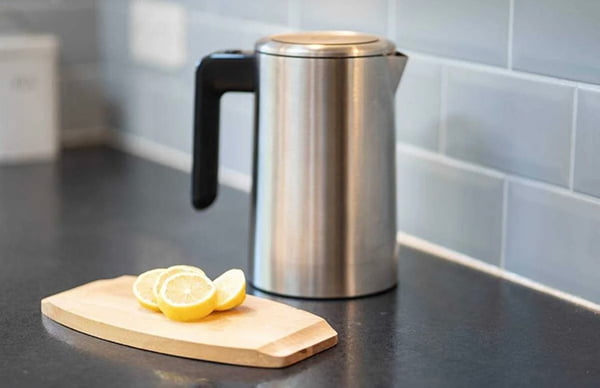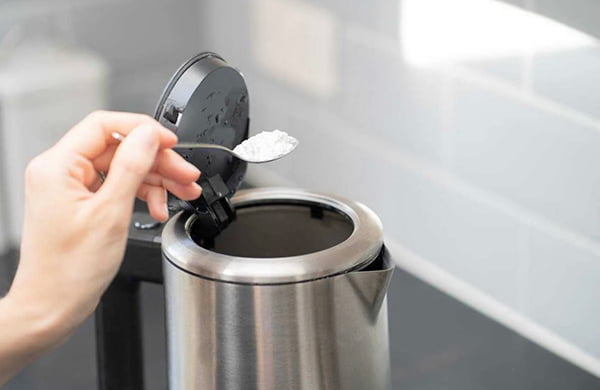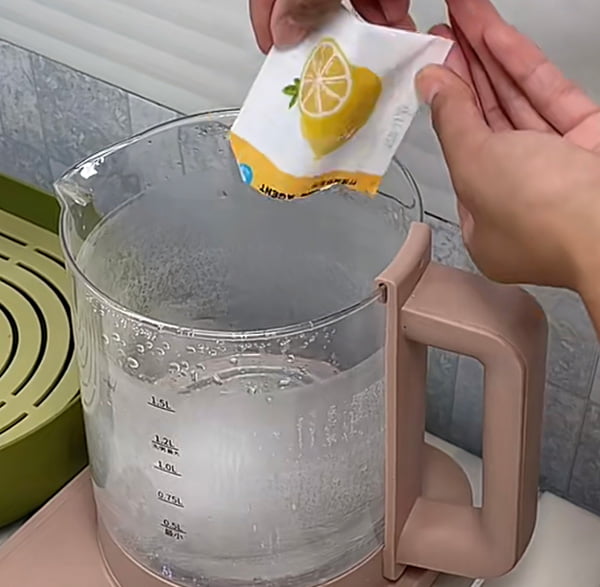Electric kettles are a kitchen essential for boiling water for tea and coffee enthusiasts, often used daily. Cleaning the outside is easy, but the inside is often neglected. Over time, natural minerals in the water can cause limescale buildup, also known as kettle furring. This looks unappealing and alters the taste of the heated water. Moreover, the accumulation of hard minerals can hinder the overall performance of your electric kettle. Regular cleaning ensures your kettle functions optimally and always provides the best hot beverages.
Limescale buildup is hard and adheres firmly to the inside of an electric kettle. So, what's the best way to remove it? Is there a way to clean it regularly to prevent the buildup from getting out of control? In this guide, we'll guide you through the steps to get your electric kettle clean.
How To Clean The Inside Of An Electric Kettle
How To Clean Electric Kettle With Vinegar

White vinegar can effectively dissolve mineral deposits inside your electric kettles. It rivals specialized descaling solutions in effectiveness but has the added advantage of being completely safe to consume. Moreover, chances are you already have white vinegar in your pantry, making it a readily available option to clean your electric kettle immediately!
Prepare The Vinegar Solution
Mix 1 part distilled white vinegar with three parts fresh water to create a vinegar solution for cleaning your electric kettle. The quantity of the solution will vary based on the size of your kettle. Try to fill about one-third of the kettle with the vinegar solution.
Boil The Solution And Let It Sit
Turn the electric kettle on and let it bring the water and distilled white vinegar to a boil. Afterward, switch off the kettle and let the solution sit for 20 minutes. For heavy mineral buildup, leave the solution to sit overnight.
Rinse Thoroughly
Pour the white distilled vinegar and water out of the kettle, then rinse it with fresh water to remove any lingering vinegar taste or odor. To remove residual vinegar, fill the kettle with water, boil it, and pour the hot water. Repeat this process two or three times for best results.
How To Clean An Electric Kettle With Lemon Juice

The acidity of lemon juice works well to break down any mineral buildup inside the kettle. You also need to worry less about thoroughly rinsing the kettle afterward because that light lemon flavor will probably pair well with your tea the next day! The citric acid powder works similarly to lemon juice and can be found in grocery stores near the spices or the canning and preserving equipment.
Prepare The Solution
Squeeze the juice from fresh lemons into a container, or use bottled lemon juice if you have it. Depending on the kettle size and buildup, use the juice of one to two lemons to clean it effectively. And then, pour just enough water into your electric tea kettle to cover the bottom.
Boil The Solution
Set the kettle on its base, switch it on, and let the solution boil. After boiling, turn off and unplug the kettle.
Let It Sit
Let the solution sit in the kettle for 15-20 minutes, allowing the lemon juice's acidic properties to dissolve limescale and mineral deposits.
Rinse Thoroughly
Pour the cleaning solution from the kettle, then rinse it thoroughly with clean water. Any lingering lemon scent will likely be a pleasant addition, but if you want to remove it completely, bring the rinse water to a boil before pouring it out.
How To Clean An Electric Tea Kettle With Baking Soda

Baking soda is renowned as a versatile all-purpose cleaner and effective abrasive. This makes it effective at removing any mineral buildup inside your electric kettle!
Create The Solution
Add two teaspoons of baking soda to the kettle, filling it halfway with water. Stir the solution with a wooden spoon until it dissolves completely.
Let It Sit
Let the baking soda paste sit in the kettle for 15-20 minutes, allowing it to work effectively on the stains and deposits.
Scrub The Interior
Following the soaking time, gently scrub the kettle's interior with a soft sponge or cloth. Baking soda's abrasive properties will help remove stains and residues.
Rinse Thoroughly
Empty the paste from the kettle and rinse it thoroughly with clean water. Ensure that no residual is left inside.
To tackle stubborn stains that are difficult to remove, follow these steps:
- Dip a damp sponge or soft cloth into a small amount of dry baking soda.
- Use the baking soda-coated sponge or cloth to scrub the affected area gently.
- After scrubbing, thoroughly rinse the area to remove any residue.
- Inspect the spot to check if it's been successfully removed. If not, consider repeating the process or exploring alternative cleaning methods.
How To Clean An Electric Kettle With Citric Acid

Using citric acid to clean electric kettles is a natural and effective way to eliminate limescale and mineral deposits.
Prepare The Solution
Create a solution by mixing 1-2 tablespoons of citric acid with water. The quantity may vary based on the extent of limescale buildup.
Fill The Kettle
Fill the kettle about halfway with the solution, adjusting the quantity based on your kettle's size and buildup.
Boil The Solution
Set the kettle on its base and switch it on. Allow the solution to boil, then turn off and unplug the electric kettle.
Let It Sit
Let the solution sit in the kettle for approximately 15-20 minutes. The citric acid will effectively dissolve the limescale and mineral deposits during this period.
Scrub The Interior
After the soaking time, gently scrub the kettle's interior with a soft sponge or cloth. Focus on areas with stubborn deposits for thorough cleaning.
Rinse Thoroughly
Empty the solution from the kettle and rinse it thoroughly multiple times with clean water. Ensure there are no residual traces inside the kettle.
How Often To Clean An Electric Kettle
Regularly cleaning an electric kettle is essential to maintain its performance and ensure that each cup of tea tastes perfect, especially if you steep tea directly in the kettle. After each use, a simple rinse with clean water can keep the kettle in good condition.
Descaling, which involves using one of the methods mentioned earlier, depends on the hardness of your water unless you use distilled water. Tap water contains calcium and magnesium minerals, which are left behind during boiling and lead to buildup inside your electric kettle. If your water is hard with more minerals, descaling may be needed more often. Typically, descaling the electric kettle once a month is recommended, especially if it is used daily.
You can use softer water to reduce the need for frequent descaling. Installing a water filter cartridge on your faucet will help remove some of these loose minerals, leading to less buildup in your electric kettle.
How To Clean The Outside Of The Kettle
In addition to the inside, remember to clean the outside of your electric kettle occasionally to maintain its countertop appeal. It can accumulate water splashes and grease from regular kitchen use.
How To Clean With Dish Soap
It's wise to avoid using dish soap inside your electric kettle. As always, check the manufacturer's directions for your specific kettle. However, it's effective at cutting through grease residue that might have gathered on the outside!
- Use warm water and dishwashing liquid to wash the outside of the electric kettle by hand, taking care never to submerge the kettle in soapy water. Remember, this is an electric kettle containing electrical components to the heating element that must be kept dry!
- Use a damp cloth to wipe the kettle, then dry it with a dish towel.
How To Clean With Olive Oil
Olive oil is the perfect polishing agent for buffing your stainless steel kettle. After you've used dish soap to remove any grease, olive oil can bring your kettle back to its original shine.
- Apply a few drops of olive oil on a microfiber cloth or non-abrasive sponge. Take care that your cleaning cloth or sponge is fully non-abrasive, or you will find yourself ruining the finish rather than shining it!
- Gently rub the cloth over the outside of your kettle. Apply enough pressure to buff out water spots.

